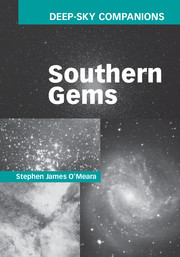Description
Deep-Sky Companions: Southern Gems
Author: O'Meara Stephen James
This text presents 120 deep-sky objects for southern hemisphere stargazers, each accompanied by beautiful images, finder charts and lucid commentary.
Language: English
Subject for Deep-Sky Companions: Southern Gems:
Approximative price 56.32 €
In Print (Delivery period: 14 days).
Add to cart
Publication date: 04-2013
450 p. · 18.5x26 cm · Hardback
450 p. · 18.5x26 cm · Hardback
Description
/li>Contents
/li>Biography
/li>
In Southern Gems, Stephen James O'Meara makes a detour beneath the southern skies, presenting a fresh list of 120 deep-sky objects for southern hemisphere stargazers to observe. Showcasing many exceptional objects catalogued by the pioneering observer James Dunlop, known as the 'Messier of the southern skies', all are visible through small- to moderate-sized telescopes or binoculars under dark skies. The list features some of the blackest dark nebulae, icy blue planetary nebulae and magnificent galaxies of all types. Each object is accompanied by beautiful photographs and sketches, original finder charts, visual histories and up-to-date astrophysical background information. Whether you live in the southern hemisphere or are just visiting, this new Deep-Sky Companion will make a perfect observing partner, whatever your background. There is no other southern sky guide like it on the market.
Preface; 1. How to use this book; 2. The southern gems; Appendix A. Southern gems: basic data; Appendix B. Forty-two additional southern gems in Dunlop's catalogue; Appendix C. A brief history of early telescopic exploration of the far-southern skies; Appendix D. Photo credits; The southern gems checklist; Index; Wide-field star charts.
Stephen James O'Meara is the author of several highly acclaimed books, including others in the celebrated Deep-Sky Companions series, and is well known among the astronomical community for his engaging and informative writing style and for his remarkable skills as a visual observer. O'Meara spent much of his early career on the editorial staff of Sky and Telescope before joining Astronomy magazine as its Secret Sky columnist and a contributing editor. An award-winning visual observer, he was the first person to sight Halley's Comet on its return in 1985 and the first to determine visually the rotation period of Uranus. One of his most distinguished feats was the visual detection of the mysterious spokes in Saturn's B-ring before spacecraft imaged them. Among his achievements, O'Meara has received the prestigious Lone Stargazer Award, the Omega Centauri Award and the Caroline Herschel Award. Asteroid 3637 was named O'Meara in his honor by the International Astronomical Union. In his spare time, he travels the world to document volcanic eruptions. He is a contract videographer for National Geographic Digital Motion and a contract photographer for the National Geographic Image Collection.
© 2024 LAVOISIER S.A.S.
These books may interest you

Herschel 400 Observing Guide 58.62 €



